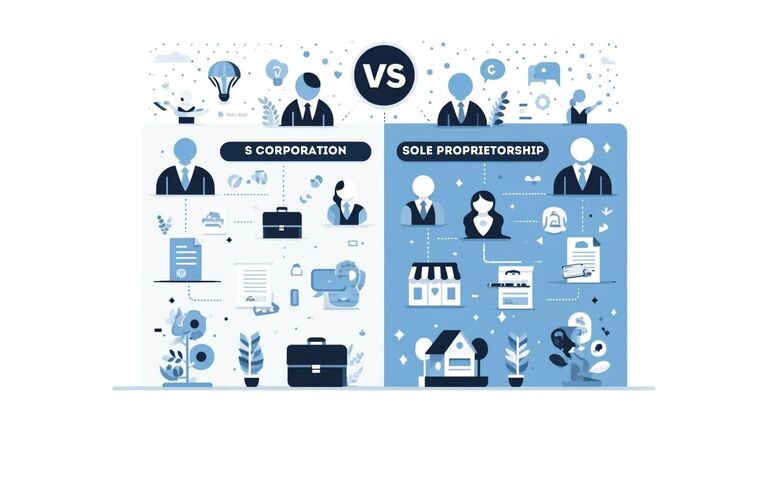S corporation vs sole proprietorship: What tax classification to choose?

Choosing the right tax classification for your business is critical to your financial health, liability protection, and administrative responsibilities.
Two popular options for small business owners are the sole proprietorship and the S corporation. Each structure has its advantages and disadvantages, so it is important to understand the differences in order to make an informed decision.
Understanding of basics
What is a sole proprietorship?
A sole proprietorship is the simplest and most common business structure. In this structure, there is no legal distinction between the owner and the business. This means that the owner is personally responsible for all business debts and obligations.
Sole proprietorships are easy to form and have minimal regulatory requirements, making them an attractive option for small business owners and professionals.
What is an S corporation?
An S corporation (S corp) is a type of corporation that provides limited liability protection to its shareholders while allowing income to pass through to the shareholders' personal tax returns.
This structure helps avoid the double taxation typically associated with traditional corporations. S corps must comply with certain Internal Revenue Code requirements, including limitations on the number and type of shareholders.
Key differences between a sole proprietor and an S corporation
Liability protection
One of the most critical factors in choosing a business structure is liability protection. This aspect determines the extent to which your personal assets are at risk in the event of business debts or legal problems.
- Sole proprietorship. In a sole proprietorship, the owner has unlimited personal liability. This means that if the business goes into debt or is sued, the owner's personal assets, such as their home or personal savings, are at risk. There is no legal distinction between the owner and the business.
- S corporation. An S corporation provides limited liability protection. This means that the personal assets of the shareholders are generally protected from business debts and lawsuits. Shareholders' liability is typically limited to the amount they have invested in the corporation. This separation provides a significant advantage over sole proprietorships, especially for higher-risk businesses.
Taxation
Taxation is another important consideration when choosing between a sole proprietorship and an S corporation. The way your business is taxed can affect your overall financial situation.
- Sole proprietorship. Income from a sole proprietorship is reported on the owner's personal tax return using Schedule C. Business income is subject to self-employment taxes, which cover Social Security and Medicare. This can result in a higher overall tax burden because all of the business's net income is subject to these taxes.
-
S corporation. An S corporation allows income, losses, deductions, and credits to pass through to the shareholders' personal tax returns. This can result in tax savings by avoiding double taxation (taxing both the corporation and the shareholders).
In addition, S corps can pay salaries to shareholder-employees. These salaries are subject to payroll taxes, but the remaining profits distributed as dividends are not subject to self-employment tax, potentially lowering the overall tax burden.
Also read. Do S corporations get a 1099?
Also read. Filing tax return for an S corp
For instance, if you're a seasoned self-employed product developer handling significant projects in the US, a substantial portion of your income likely goes toward taxes. In this scenario, opting for an S corporation tax classification for your business could prove advantageous over being a sole proprietor.
By doing so, you can potentially reduce Social Security and Medicare taxes, as you would pay them only from your "reasonable salary" rather than your entire taxable income. Before choosing an S corp tax classification, carefully assess the potential tax benefits against the associated costs and consult your tax advisor. - Ines Zemelman EA, founder and President at TFX
Administrative complexity
The amount of administrative work required to maintain a business structure may influence your decision, especially if you prefer simplicity or have limited resources to manage complex requirements.
- Sole proprietorship. Setting up and maintaining a sole proprietorship is relatively simple and inexpensive. There are minimal regulatory requirements and little administrative burden. This structure is ideal for individuals who prefer a straightforward and easy-to-manage business model.
- S corporation. An S corporation involves more complex administrative responsibilities. These include filing articles of incorporation, adopting bylaws, holding regular meetings, maintaining detailed records, and filing annual reports and corporate tax returns.
Choosing the right structure
Deciding between a sole proprietorship and an S corporation requires careful consideration of your business goals, liability risks, and potential tax benefits. Here's how to evaluate these factors to make an informed decision.
| Factor | Sole proprietorship | S corporation |
|---|---|---|
| Business goals | Ideal if you prefer to keep operations simple and retain full control, allowing you to make quick decisions without formalities and meetings | Better suited for significant business growth or seeking outside investment due to its formal structure and limited liability protection, making it attractive to investors. |
| Liability risks | Suitable for businesses with minimal risk, but personal assets are exposed to potential financial risk. | Provides limited liability protection, shielding personal assets from business debts and lawsuits, critical for high-risk businesses. |
| Tax benefits | All net income is subject to self-employment tax, which may result in a higher overall tax burden. | Can reduce self-employment taxes by paying a reasonable salary to shareholder-employees and distributing remaining profits as dividends, which are not subject to self-employment taxes. |
Also read. S corporation tax benefits
Setting up and maintaining the structure
Sole proprietorship
- Registration. Register your business name with your state or local government, if required. This step may include filing a "Doing Business As" (DBA) name.
- Licenses and permits. Obtain all necessary licenses and permits based on your industry and location. This may include local business licenses, health permits, and other industry-specific permits.
- Taxes. Apply for an Employer Identification Number (EIN) if you plan to hire employees. Report business income and expenses on Schedule C of your personal tax return. You may also need to register for state and local taxes, including sales tax if you sell taxable goods or services.
- Banking and finances. Open a separate business bank account to keep your personal and business finances separate.
S corporation
- Incorporate. File Articles of Incorporation with your state and pay any required filing fees. This document contains basic information about your corporation, such as its name, address, and the names of the incorporators.
- Election. File Form 2553 with the IRS to elect S corporation status. This form must be filed within two months and 15 days after the beginning of the tax year in which the election is to be effective.
- Compliance. Comply with state and federal regulations, including holding regular meetings, maintaining detailed corporate records, and filing annual reports. Document all major business decisions and keep minutes of meetings.
- Taxes and payroll. File corporate tax returns and ensure that all income, losses, deductions, and credits pass through to the shareholders' personal tax returns. Pay yourself a reasonable salary as a shareholder-employee and file payroll taxes accordingly.
Bottom line
The choice between an S corporation and a sole proprietorship depends on your specific business needs, goals, and risk tolerance. Sole proprietorships offer simplicity and ease of management, making them ideal for small, low-risk businesses. However, they expose owners to unlimited personal liability.
S corporations, on the other hand, offer limited liability protection and potential tax savings but require more rigorous management.
Consulting with a CPA or tax professional can help you navigate these complexities and make an informed decision that aligns with your business goals.
Your business structure is the key to tax savings.
Get a tax planning consultation.
Disclaimer: This article is for informational purposes only and does not constitute legal or tax advice. Always consult with a tax professional regarding your specific case.

Ines Zemelman, EA, is the founder and president of TFX, specializing in US corporate, international, and expatriate taxation. With over 30 years of experience, she holds a degree in accounting and an MBA in taxation. See more
Further reading
![Guide to S corp taxes [+ 25 FAQs answered by tax pros]](https://tfxstorageimg.s3.amazonaws.com/5ive22zs5rfzfaniwnoxx88emcud)
